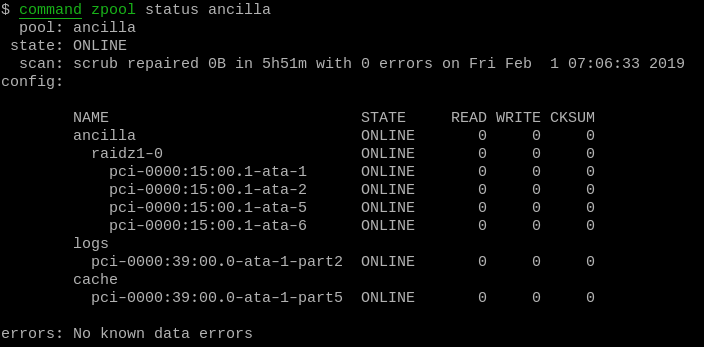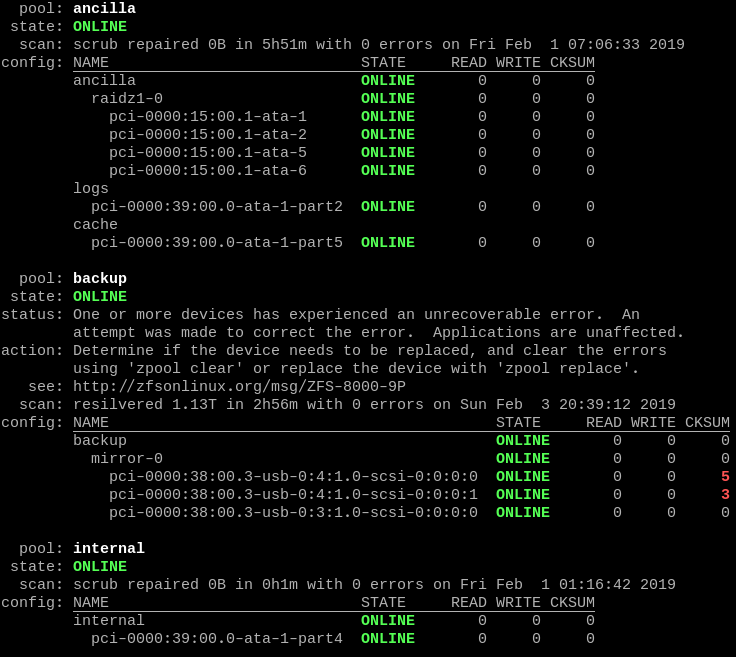A prettier zpool status
I run ZFS on my server, and that means I’m often looking at the output of zpool status, especially when shuffling drives around. Out of the box, however, it’s kind of bland and has lots of wasted space:

Using the subcommand wrapper from the last post, though, we can easily replace this with something prettier. I’ll be using terminal control codes for this; a full discussion of them is outside the scope of this post, but the only one I’ll be using is ESC [ ... m anyways, which controls the styling of text. (If you want to know more, the XTerm Control Sequences page is extensive, and the sequences described there are supported by most terminal emulators.)
For starters, let’s just make the name of the pool bold:
function zpool-status {
command zpool status "$@" | sed -E '
/^ pool:/ s/pool: (.*)/pool: \x1B[1m\1\x1B[0m/
'
}
That sed script is going to get a lot larger, though. Next, let’s compress things vertically by removing all the blank lines except the one at the end of each status block, as well as the errors: line if there are no errors to report:
/^$/ d;
/errors: No known data errors/ s,.*,,
/errors: .*/ s,$,\n,
This replaces the “no errors” line with the blank line we want, and simply inserts a newline at the end of other error lines.
Now, we move the “config:” prefix to the same line as the table header, and underline the header itself (by deleting the config: line entirely and inserting that prefix at the start of the next line):
/^config:/ d
/^\tNAME/ { s/^./config: /; s/NAME.*/\x1B[4m\0\x1B[0m/; }
We can also replace the ONLINE ... (resilvering) status with a new RESILV status:
s,ONLINE(.*) \(resilvering\),RESILV\1,
And with that sorted out, make things more colourful! ONLINE will be green, RESILV blue, DEGRADED yellow, and OFFLINE, FAULTED, REMOVED, and UNAVAIL red:
s,ONLINE,\x1B[1;32m\0\x1B[0m,
s,RESILV,\x1B[1;36m\0\x1B[0m,
s,DEGRADED,\x1B[1;33m\0\x1B[0m,
s,(OFFLINE|FAULTED|REMOVED|UNAVAIL),\x1B[1;31m\1\x1B[0m,g
And finally, we can hilight non-zero error counts in red, too. For the sake of simplicity this code makes the assumption that only those lines end with three space-separated numbers, and that the device names on the same line will never contain whitespace followed by digits.
/ [0-9]+ +[0-9]+ +[0-9]+$/ {
s, ([1-9][0-9]*), \x1B[1;31m\1\x1B[0m,g
}
And there we go!

The whole thing put together can now be put in ~/.zshrc, and as long as enable-subcommands-for zpool is run at some point, it’ll just work.
function zpool-status {
command zpool status "$@" | sed -E '
# name of pool in bold
/^ pool:/ s/pool: (.*)/pool: \x1B[1m\1\x1B[0m/
# delete blank lines
/^$/ d
# if no errors, replace "errors:" line with blank line; otherwise preserve
# and append newline
/errors: No known data errors/ s,.*,,
/errors: .*/ s,$,\n,
# move config: prefix to the start of the table header; underline the header
/^config:/ d
/^\tNAME/ { s/^./config: /; s/NAME.*/\x1B[4m\0\x1B[0m/; }
# If any of the error counts are non-zero, hilight them in red
/ [0-9]+ +[0-9]+ +[0-9]+$/ {
s, ([1-9][0-9]*), \x1B[1;31m\1\x1B[0m,g
}
# remove (resilvering) and replace the status with it
s,ONLINE(.*) \(resilvering\),RESILV\1,
# make ONLINE green, RESILV blue, DEGRADED yellow, and other statuses red.
s,ONLINE,\x1B[1;32m\0\x1B[0m,
s,RESILV,\x1B[1;36m\0\x1B[0m,
s,DEGRADED,\x1B[1;33m\0\x1B[0m,
s,(OFFLINE|FAULTED|REMOVED|UNAVAIL),\x1B[1;31m\1\x1B[0m,g
'
}